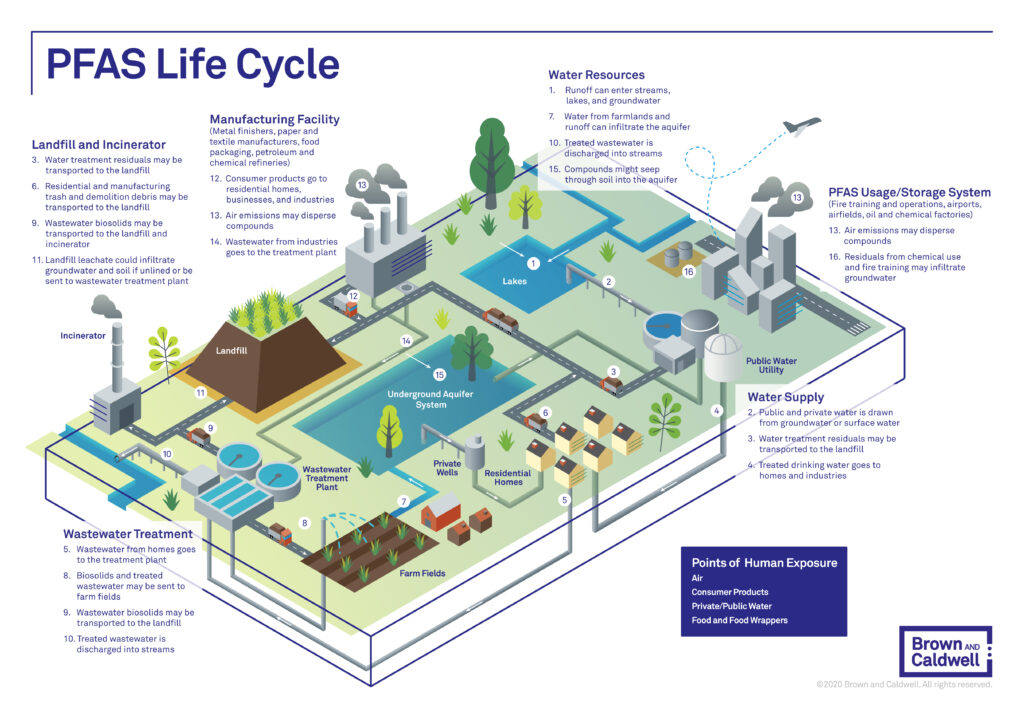On Oct. 18, 2021, the EPA unveiled its PFAS Strategic Roadmap, a plan to investigate and regulate PFAS (per- and polyfluoroalkyl substances) compounds in air, water, soil, and biosolids.
The roadmap is framed around human and ecological toxicity and exposure research, restrictions on PFAS releases to the environment, and accelerating the remediation of PFAS contamination. This plan highlights the agency’s commitment to focus on PFAS sources, establishing a PFAS regulatory framework, and developing standards that will evolve based on toxicological studies and other actions.
The approach targets the full lifecycle of PFAS and will be implemented under several federal laws and through agencies beyond the EPA, including the White House Council of Environmental Quality, Department of Agriculture, Food and Drug Administration, and others. The details and effects of the roadmap are certain to evolve over time, but there are regulations and changes that have already started to impact the regulated community. The following breaks down the who, where, why, and how of the EPA’s PFAS Strategic Roadmap.
Who
Drinking water utilities
With a significant focus on developing enforceable drinking water standards for certain PFAS, the roadmap will certainly impact drinking water utilities through changes in standards, advisories, and testing.
Wastewater utilities
The roadmap states that the agency wants to “get upstream of the problem” and intervene before PFAS compounds have entered the environment. This will have impacts on publicly owned wastewater treatment works (POTWs) and their industrial dischargers.
Private sector/industrial facilities
Forthcoming federal PFAS regulation will potentially impact a broad cross section of the regulated industrial community, especially those that have stored aqueous film-forming foams as part of fire protection systems. Wastewater dischargers and solid waste generators with facilities dealing with PFAS at varying points in its lifecycle will need to consider their PFAS risk. The roadmap will reach across industry sectors including facilities engaged in:
- Electrical and electronic component manufacturing facilities
- Textile mills
- Landfills
- Pulp, paper, and paperboard facilities
- Airports
- Organic chemicals, plastics and synthetic fibers (OCPSF)
- Metal finishing
- Electroplating
- Leather tanning and finishing
- Plastics molding and forming
- Paint formulating

Why
Now found in the water, soil, and air in almost all areas of the country, PFAS have become an urgent public health and environmental issue. EPA’s Council on PFAS was tasked with developing a plan of action to learn more about PFAS through research and science as well as create a path forward to protect human health and the environment. The resulting plan of action was the PFAS Strategic Roadmap, which aims to address the full PFAS lifecycle from preventing new contamination through remediation of existing contamination.
Where
Until now, only certain states have regulated PFAS. The lack of uniformity in PFAS regulation has resulted in varying numeric criteria and media regulated. This regulatory mishmash can be difficult to manage for companies that operate across the country. For example, state level PFAS roadmap-like documents have come out of Wisconsin, Minnesota, Michigan, and Washington, and other states likely have or are developing strategic guidance for PFAS regulation. The federal actions outlined in the EPA Roadmap mean that all states will be involved in implementing new federal PFAS regulations.
How
The roadmap has a heavy focus on regulatory means to address contamination. While regulations have been put into place in certain states, the roadmap makes it clear that the EPA’s intention is to increase reporting and regulatory requirements. The EPA’s plan follows many states where PFAS regulation has already been instituted. It is expected that upcoming federal actions will impact industry and water utilities by way of monitoring and reporting, source reduction, and environmental compliance. The EPA recommends PFAS monitoring in industrial and municipal wastewater, BMPs for stormwater, public notification for downstream PWS and communities, and pretreatment/source control.
Indeed, we are already seeing PFAS monitoring in National Pollutant Discharge Elimination System (NPDES) permits issued prior to the roadmap. To accomplish monitoring and compliance objectives identified in the roadmap, the agency outlines standards for testing methodology. With the draft validation of EPA Method 1633, detection capabilities have expanded to include a broader suite of 40 PFAS compounds in eight environmental media. It is anticipated that the expanded analytical capacity will open the door for more extensive regulations and monitoring.
Longer range goals identified in the roadmap are the development of PFAS treatment, remediation, destruction, disposal, and mitigation technologies. Coinciding with the potential PFAS listing under Comprehensive Environmental Response, Compensation, and Liability Act (CERCLA) and Resource Conservation and Recovery Act (RCRA), these technological advances will integrate into PFAS management, disposal, and remediation.


